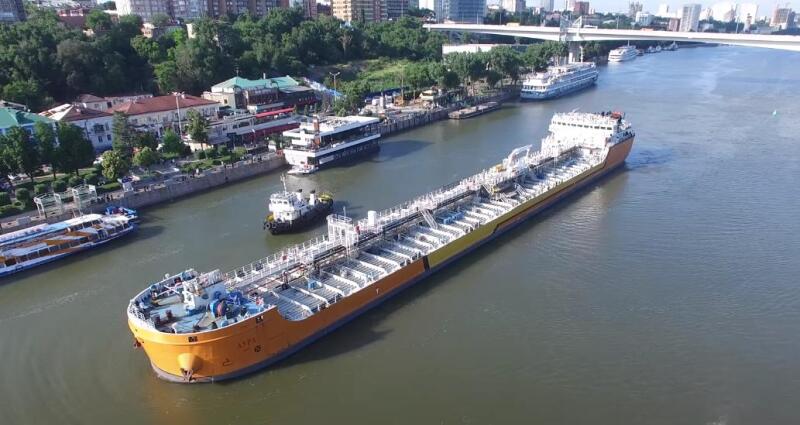If the number of a regular oil tanker varies between 6 and 12, then in a chemical tanker the number of tanks can reach up to 20. All of them are sealed and divided into categories. Some are intended for the transportation of dangerous acids and other liquids, others for liquid food products, etc. It is not allowed to transport substances in compartments that are not intended for this.
Types of chemical tankers
There is an international code, the IBC Code, according to which all ships of this type are divided into three types according to design. The first category includes ships with double sides and bottom. This is done to prevent chemicals from leaking out into the natural environment in the event of an accident - for example, in a collision or grounding. Such ships transport the most dangerous cargo, including those that ignite at temperatures below +65°. The minimum distance from the side to the tank is from 11,5 m.
 Schematic representation of a chemical tanker of the third type. Photo: YouTube.com
Schematic representation of a chemical tanker of the third type. Photo: YouTube.comThe second type also has a duplicate system. The only difference is that a shorter distance to the nearest tank is allowed here - 7,6 m. Chemical tankers of the third type do not have a double structure, only an internal bulkhead running along the ship. Based on deadweight (weight of commercial load), tankers are also divided into three types:
✅ Inland Chemical – river vessels (up to 4 thousand tons)
✅ Coastal Chemical - coastal and sea navigation (up to 10 thousand tons)
✅ Deep Sea – long-distance transportation (up to 75 thousand tons)
On board chemical tankers of any type there is a security system, which is measuring equipment that shows the level of cargo, its temperature, pressure and the presence of gases in the tanks.
 Cooling the deck of a chemical tanker. Photo: YouTube.com
Cooling the deck of a chemical tanker. Photo: YouTube.comThey also provide entire pipelines necessary for cooling or heating the transported substances. Otherwise, some of them may explode if the temperature is not lowered. Others tend to harden to the density of concrete if they are not heated.
How chemical tankers are loaded and unloaded
Before sending the next batch of substances to the tanks, they are washed and disinfected. During this procedure, a tank washing machine is used - a special device that ensures cleaning of all internal surfaces. Washing sometimes lasts several days, then the tanks are dried. But that's not all!
 When loading a chemical tanker, special clothing is used. Photo: YouTube.com
When loading a chemical tanker, special clothing is used. Photo: YouTube.comBefore loading the product, the compartments are filled with nitrogen to prevent the possible formation of a spark and ignition of the substance. Often the ship has its own gas production plant, but sometimes it is purchased at the port. And only after this the pumping of liquids and substances into the vessel begins.
 Chemical tanker pump system. Photo: YouTube.com
Chemical tanker pump system. Photo: YouTube.comLoading is carried out using shore pumps, tanks are being released using on-board pumps. They also take samples of chemicals before they reach the ship, then after they are placed in tanks and upon arrival at the port of destination.
Chemical carriers in the world and Russia
The largest tanker for transporting chemicals is Stolt Sagaland, launched in 2008 and owned by Stolt-Nielsen (Norway). The vessel is adapted for transporting liquid cargo, including the most aggressive ones. There are 24 stainless steel tanks with epoxy coating for them. The other 15 transport raw materials such as vegetable oil and flavorings.
 Russian inland chemical tanker. Photo: YouTube.com
Russian inland chemical tanker. Photo: YouTube.comIn the Russian Federation, the Astrakhan enterprise Lotos is engaged in the construction of chemical tankers. In April last year, the next tanker “Volgotrans-2501” of the RST-25 project was delivered to the customer. It has six insulated compartments and is adapted for simultaneous transportation of vegetable oil, chemicals, and petroleum products.










